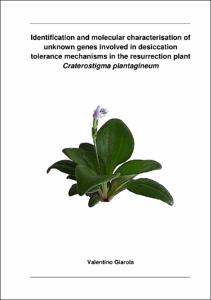Identification and molecular characterisation of unknown genes involved in desiccation tolerance mechanisms in the resurrection plant Craterostigma plantagineum

Identification and molecular characterisation of unknown genes involved in desiccation tolerance mechanisms in the resurrection plant Craterostigma plantagineum

| dc.contributor.advisor | Bartels, Dorothea | |
| dc.contributor.author | Giarola, Valentino | |
| dc.date.accessioned | 2020-04-20T03:12:08Z | |
| dc.date.available | 2020-04-20T03:12:08Z | |
| dc.date.issued | 06.11.2014 | |
| dc.identifier.uri | https://hdl.handle.net/20.500.11811/6190 | |
| dc.description.abstract | The mechanisms that enable vegetative desiccation tolerance in the resurrection plant Craterostigma plantagineum are not fully understood. Recently, transcriptome data from this plant were obtained thus providing gene sequence information for molecular studies. Here C. plantagineum is used as an experimental system to characterise desiccation tolerance mechanisms in vegetative parts of plants. The use of RT-qPCR to study gene expression in C. plantagineum is hampered by the lack of validated stable reference genes which are required to normalise data. To overcome this limitation, the expression stability of eight candidate reference genes (ACT, CAC, EF1α, EIF5A, GAPDH, TKT3, PP2AA3, YLS8) was tested in leaves and roots during desiccation and rehydration and in callus upon desiccation and ABA treatment. YLS8, EIF5A and TKT3 were identified as optimal reference genes for normalizing gene expression data in leaves, EF1α, EIF5A and GAPDH for roots and YLS8, CAC and GAPDH for callus. Next, three unknown genes which are differently modulated during dehydration and rehydration were selected from the C. plantagineum transcriptome data and molecularly characterised. One of these genes codes for a glycine-rich protein 1 (CpGRP1). CpGRP1 transcript and protein accumulate during dehydration in leaves. Promoter studies showed that the CpGRP1 gene expression involves a drought responsive cis-element (DRE). The secretion of CpGRP1 into the apoplasm was demonstrated with GFP fusion proteins. CpGRP1 shows sequence similarities with the Arabidopsis thaliana glycine-rich protein 3 (AtGRP-3) which is known to interact with cell wall associated protein kinases (AtWAKs). Two AtWAK homologs were identified in C. plantagineum and an interaction was demonstrated between one of them, i.e., CpWAK1 and CpGRP1. Cell expansion in A. thaliana requires WAKs. It was shown that CpWAKs genes are downregulated during dehydration. Data suggest that CpWAKs might be working similarly to AtWAKs controlling cell volume and cell folding during dehydration; the activity of CpWAKs may be regulated by CpGRP1. The other two selected genes code for a cysteine-rich rehydration-responsive protein 1 (CpCRP1) and an early dehydration-responsive protein 1 (CpEDR1). CpCRP1 and CpEDR1 did not show any similarity to genes in other species. Genes which occur only in some species are defined as orphan or taxonomically restricted genes and may be important for the evolution of new traits. In silico sequence analyses predicted that both genes are likely to interact with other cellular components and are localised in two different cellular compartments. GFP fusion proteins demonstrated that CpCRP1 is secreted into the apoplasm whereas CpEDR1 is imported into chloroplasts. Putative homologs of CpCRP1 and CpEDR1 were identified in Lindernia brevidens and Lindernia subracemosa which belong to the same family as C. plantagineum thus suggesting a recent evolution of the genes in this family. According to expression profiles, CpCRP1 may play a role in normal conditions and during rehydration whereas CpEDR1 may be required for the acquisition of desiccation tolerance and protect photosynthetic structures during dehydration and rehydration. | en |
| dc.language.iso | eng | |
| dc.rights | In Copyright | |
| dc.rights.uri | http://rightsstatements.org/vocab/InC/1.0/ | |
| dc.subject | Trockenstress | |
| dc.subject | Wiederauferstehungspflanzen | |
| dc.subject | Zellwandproteine | |
| dc.subject | Genaktivierung | |
| dc.subject | Spezies-spezifische Gene | |
| dc.subject | Stressproteine | |
| dc.subject | Orphan genes | |
| dc.subject | Taxonomically restricted genes | |
| dc.subject.ddc | 500 Naturwissenschaften | |
| dc.subject.ddc | 570 Biowissenschaften, Biologie | |
| dc.subject.ddc | 580 Pflanzen (Botanik) | |
| dc.title | Identification and molecular characterisation of unknown genes involved in desiccation tolerance mechanisms in the resurrection plant Craterostigma plantagineum | |
| dc.type | Dissertation oder Habilitation | |
| dc.publisher.name | Universitäts- und Landesbibliothek Bonn | |
| dc.publisher.location | Bonn | |
| dc.rights.accessRights | openAccess | |
| dc.identifier.urn | https://nbn-resolving.org/urn:nbn:de:hbz:5n-37962 | |
| ulbbn.pubtype | Erstveröffentlichung | |
| ulbbnediss.affiliation.name | Rheinische Friedrich-Wilhelms-Universität Bonn | |
| ulbbnediss.affiliation.location | Bonn | |
| ulbbnediss.thesis.level | Dissertation | |
| ulbbnediss.dissID | 3796 | |
| ulbbnediss.date.accepted | 02.10.2014 | |
| ulbbnediss.institute | Mathematisch-Naturwissenschaftliche Fakultät : Fachgruppe Biologie / Institut für Molekulare Physiologie und Biotechnologie der Pflanzen (IMBIO) | |
| ulbbnediss.fakultaet | Mathematisch-Naturwissenschaftliche Fakultät | |
| dc.contributor.coReferee | Dörmann, Peter |
Files in this item
This item appears in the following Collection(s)
-
E-Dissertationen (4400)




